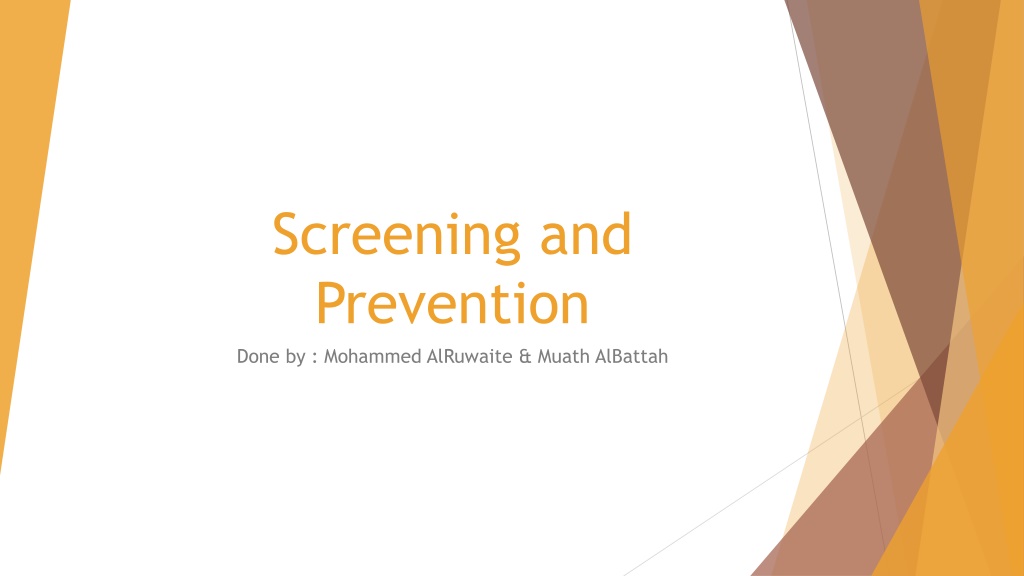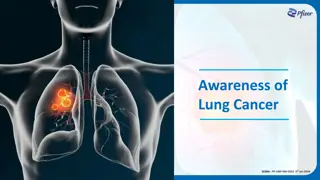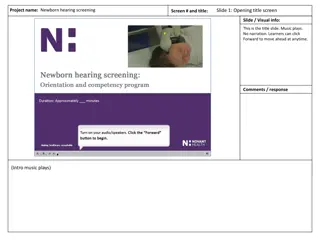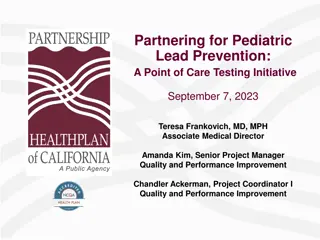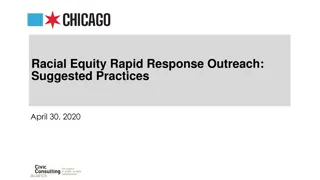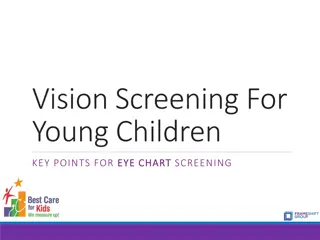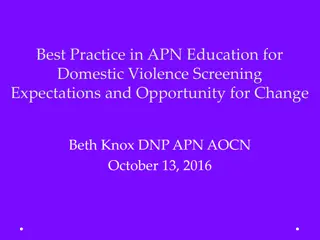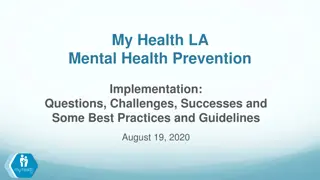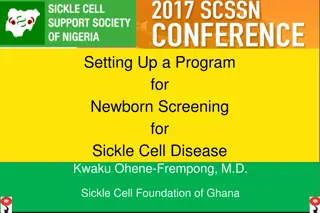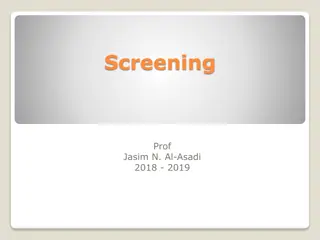Screening and Prevention in Family Practice
Definition of screening and prevention in family practice along with the Wilson-Jungner criteria, types of screening tests, and examples like colonoscopy and breast cancer screening. Objectives include understanding screening types and targeted populations, pros and cons of screening, and appropriate prevention approaches. Emphasis on early detection and treatment of serious conditions through screening.
Download Presentation

Please find below an Image/Link to download the presentation.
The content on the website is provided AS IS for your information and personal use only. It may not be sold, licensed, or shared on other websites without obtaining consent from the author.If you encounter any issues during the download, it is possible that the publisher has removed the file from their server.
You are allowed to download the files provided on this website for personal or commercial use, subject to the condition that they are used lawfully. All files are the property of their respective owners.
The content on the website is provided AS IS for your information and personal use only. It may not be sold, licensed, or shared on other websites without obtaining consent from the author.
E N D
Presentation Transcript
Screening and Prevention Done by : Mohammed AlRuwaite & Muath AlBattah
Q1/ Which one of the following is not on Wilson-Jungner criteria? A. Natural history of illness is well understood B. Detectable at early age C. Acceptable to the population D. Test has to be highly specific
Q2/ Pan-retinal photocoagulation in diabetic retinopathy is considered what type of prevention? A. Primary prevention B. Secondary prevention C. Tertiary prevention D. None of the above
Q3/ Which one of the following tests is not of use for colorectal carcinoma screening? A. Colonoscopy B. Faecal occult blood (FOB) C. The fecal immunochemical test (FIT) D. None of the above
Objectives To Define screening / prevention and its uses in family practice To understand the Criteria for screening tests To identify Screening types and targeted people for each type with examples. To explain pros and cons of screening . To identify appropriate approaches for prevention and screening of common problems in primary care . To justify the rational for selection of a screening test with practical case /condition, examples like for CA. breast, Ca. colon, Ca. prostate
Screening it is the ability to diagnose and treat a potentially serious condition at an early stage when it is still treatable. (pt asymptomatic) Ie : An ideal screening test must pick up all those who have the disease (have high sensitivity) and must exclude those who do not (high specificity)
Screening types Mass screening: applied on a large unselected group or an entire population, test should be cheap, fast, and reliable. High risk group screening: applied on a specific group with a known high risk for the screened disease.
The WilsonJungner criteria: The condition being screened for is an important health problem Intervals for repeating the test have been determined Natural history of the condition is well understood Adequate health service provision has been made for the extra clinical workload resulting from screening There is a detectable early stage Treatment at early stage is of more benefit than at late stage Risks, both physical and psychological, are < benefits There is a suitable test to detect early stage disease The test is acceptable to the target population Costs are worthwhile in relation to benefits gained
Advantages Disadvantages - Improved prognosis for some cases detected by screening - Longer morbidity in cases where prognosis is unaltered - Overtreatment of questionable abnormalities - False reassurance for those with false-negative results - Anxiety and sometimes morbidity for those with false-positive results - Unnecessary intervention for those with false-positive results - Hazards of some screening tests - Diversion of resources to the screening programme - Less radical treatment for some early cases - Reassurance for those with negative test results - Increased information on natural history of disease and benefits of treatment at early stage
Prevention In all disease, the goal is prevention. Prevention, consists of methods or activities that seek to reduce or deter specific or predictable problems, protect the current state of well-being, or promote desired outcomes or behaviors.
Prevention types 1- Primary prevention Prevention of disease occurrence. (health education, vaccination etc .) 2- Secondary prevention Controlling disease in early form (e.g. carcinoma in situ, treating acute MI) 3- Tertiary prevention Prevention of complications once the disease is present (e.g. DM complications, rehabilitation)
Appropriate screening and prevention of common problems in primary care
Common conditions to be screened for in primary care include?... - Hypertension - Diabetes mellitus - Breast Cancer - Colon Cancer - Prostate Cancer - CVD risk assessment - Etc
Diabetes mellitus def: a chronic syndrome of impaired carbohydrate, protein and fat metabolism owing to insufficient secretion of insulin or to target tissue insulin resistance. A very common disease in KSA (23.7%*) of adults aged 30- 70 years of age. A disease with debilitating complications (DR, ESRD, amputations, CAD.) Potentially preventable, and complications can be avoidable. Patients with Impaired Glucose Tolerance may benefit from intervention such as lifestyle modifications or pharmaceutical agents.
Screening for DM The U.S. Preventive Services Task Force recommends screening for abnormal blood glucose and type 2 diabetes in adults 40 to 70 years of age who are overweight or obese, and repeating testing every 3 years if results are normal. Screen all adults who are overweight ( BMI 25 kg/ m2) and have additional risk factors. Not recommended for t1 DM. Prevention of DM - Type1 DM can t be prevented? - Type 2 might be prevented if caught early (IGT) with lifestyle modifications(diet and exercise) and/or drugs (metformin). As for the complications of DM, renal, cardiovascular and neurological complications maybe prevented or
Hypertension Also common in KSA (26.1%) of adults aged 30-70 years of age, It is the most commonly diagnosed condition at outpatient office visits. High blood pressure is a major risk factor to heart failure, heart attack, stroke, and chronic kidney disease. An important feature of hypertension is that it remains asymptomatic until target tissue damage has already happened, hence the importance of screening programs.
Screening for HTN (USPTF) Annual screening for adults aged 40 years or older and for those who have high-normal blood pressure (130 to 139/85 to 89 mm Hg), those who are overweight or obese, and African Americans. Adults aged 18 to 39 years with normal blood pressure (<130/85 mm Hg) who do not have other risk factors should be rescreened every 3 to 5 years. The USPSTF recommends rescreening with properly measured office blood pressure and, if blood pressure is elevated, confirming the diagnosis of hypertension with ABPM.
Colorectal carcinoma. Most common cancer in Saudi males and 3rdmost common in Saudi females Late diagnosis is the major cause for the low survival rate Can be detected early and be easily managed thus screening and early diagnosis is critical especially in high risk individuals Who are the high risk idividuals? - Family history - Ulcerative colitis - Previous colorectal cancer Role of prevention?
Screening for colorectal carcinoma Screening options for colorectal carcinoma include: - Faecal occult blood (FOB) (should be screened annually if age is <70) - The fecal immunochemical test (FIT) - Flexible Sigmoidoscopy (every 5 years or 10 with annual FIT or FOB) - Colonoscopy
Breast cancer Breast cancer is the most common cancer in women worldwide and it is the most common cause of death in women aged 35-55. The incidence of breast cancer noticeably begins to increase after the age of 25 years and continues to increase until ages 75 to 79 years For women of all ages at average risk, screening was associated with a reduction in breast cancer mortality of approximately 20%
Screening for breast cancer Screening for breast cancer can be done by two methods: 1- physical examination 2- Mammography Age to start mammography screening should be after 40, and for women aged 50 and above it should be done annually(indication for stopping the screeing is when life expectancy is below 10 years) For high risk women who have family history of breast cancer and BRCA gene mutation screening should start at the age of 25 years.
Interactive case A 57 year old woman came to your clinic after noticing several lumps in her left breast and armpit, nipple and skin dimpling. what would you do? What is the role of screening and prevention in this case?
Q1/ Which one of the following is not on Wilson-Jungner criteria? A. Natural history of illness is well understood B. Detectable at early age C. Acceptable to the population D. Test has to be highly specific
Q2/ Pan-retinal photocoagulation in diabetic retinopathy is considered what type of prevention? A. Primary prevention B. Secondary prevention C. Tertiary prevention D. None of the above
Q3/ Which one of the following tests is not of use for colorectal carcinoma screening? A. Colonoscopy B. Faecal occult blood (FOB) C. The fecal immunochemical test (FIT) D. None of the above
Refrences: Oxford Handbook of General Practice, 4thedition NICE guidelines https://www.cdc.gov/cancer/colorectal/basic_info/screening/tests.htm https://jamanetwork.com/journals/jama/fullarticle/2463262 *Naeem, Zahid. Burden of Diabetes Mellitus in Saudi Arabia. International Journal of Health Sciences 9.3 (2015): V VI. Print.
